
Bury St Edmunds, commonly referred to locally as Bury, is a historic market, cathedral town and civil parish in Suffolk, England. Bury St Edmunds Abbey is near the town centre. Bury is the seat of the Diocese of St Edmundsbury and Ipswich of the Church of England, with the episcopal see at St Edmundsbury Cathedral.

Weston-under-Lizard is a village in the South Staffordshire district of Staffordshire, England. It constitutes a civil parish with Blymhill, called Blymhill and Weston-under-Lizard. It is known as Weston-under-Lizard to distinguish it from Weston-on-Trent. It should not be confused with the village of Weston, to the north east of Stafford.

Coade stone or Lithodipyra or Lithodipra was stoneware that was often described as an artificial stone in the late 18th and early 19th centuries. It was used for moulding neoclassical statues, architectural decorations and garden ornaments of the highest quality that remain virtually weatherproof today.

Bury St Edmunds railway station serves the town of Bury St Edmunds in Suffolk, England. The station is on the Ipswich–Ely line and all trains calling there are operated by Greater Anglia.
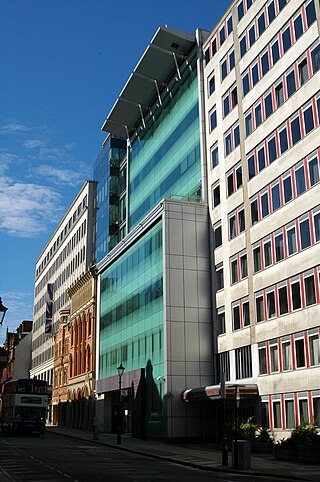
Edmund Street is a street located in Birmingham, England.

Langleybury is a country house and estate in Abbots Langley, Hertfordshire, England, about 3 miles (5 km) northwest of the centre of the town of Watford. The house stands on a low hill above the valley of the River Gade.

George Corson (1829–1910) was a Scottish architect active in Leeds, West Yorkshire, England.

Finborough Hall is a Grade II listed stucco-faced Tuscan-style country house in Great Finborough, Suffolk, England.

Brent Ditch is generally assumed to be an Anglo-Saxon earthwork in Southern Cambridgeshire, England, built around the 6th and 7th Centuries. However most of its structure has been lost over time. The site is scheduled as an ancient monument by Historic England.
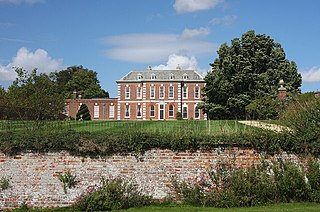
Dalham Hall is a country house and 3,300-acre (13 km2) estate, located in the village of Dalham, Suffolk, near Newmarket, and 13 kilometres (8 mi) west of Bury St Edmunds.
Pillar of salt may refer to:

Wainfleet St Mary is a village and civil parish in the East Lindsey district of Lincolnshire, England. It is situated directly south of Wainfleet All Saints on the A52 road, 5 miles (8 km) south-west from Skegness and 14 miles (23 km) north-east from Boston. The 2001 Census recorded a population of 1,106, reducing to 1,025 at the 2011 census. It includes the hamlet of Wainfleet Bank.

Moreton Hall is a Grade II* listed building in Bury St Edmunds, a market town in the county of Suffolk, England. It was designed by the Scottish architect Robert Adam and built in 1773 as a country house for John Symonds (1729–1807), a clergyman and Professor of Modern History at Cambridge University. The building was originally known as "St. Edmund's Hill". It was later called "The Mount" and from 1890 "Moreton Hall".

Greater Manchester is a metropolitan county in North West England. It was created by the Local Government Act 1972, and consists of the metropolitan boroughs of Bolton, Bury, Oldham, Rochdale, Stockport, Tameside, Trafford, Wigan and the cities of Manchester and Salford. This is a complete list of the Grade I listed churches in the metropolitan county as recorded in the National Heritage List for England. Buildings are listed by the Secretary of State for Culture, Media and Sport on the recommendation of English Heritage. Grade I listed buildings are defined as being of "exceptional interest, sometimes considered to be internationally important"; only 2.5 per cent of listed buildings are included in this grade.
Suffolk Archives manage the historical archives for the county of Suffolk. These archives include a wide range of historical council and parish records, plus various commercial records, local historic book collections, local historic newspapers and various personal items. They are accessible to view at three locations: The Hold Ipswich; Lowestoft Library, Lowestoft and Bury St Edmunds. The Hold opened in September 2020 and also hosts various exhibitions, town walks and lectures. This service is run by Suffolk County Council.
Little Horringer Hall is a Grade II-listed house in Horringer, Bury St Edmunds, Suffolk, England.
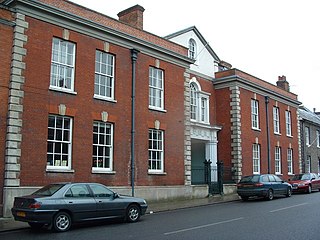
Northgate House is a Grade I listed house in Northgate Street, Bury St Edmunds. It was home to the novelist Norah Lofts from 1955 until her death in 1983.
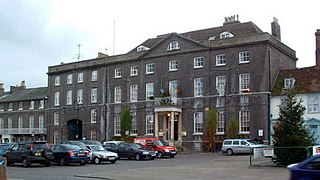
The Angel Hotel is a grade II* listed hotel in Angel Hill, Bury St Edmunds, Suffolk, England.
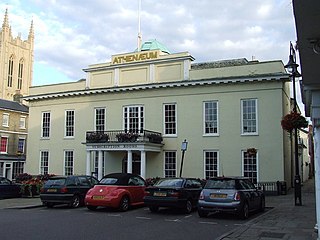
The Athenaeum, Bury St Edmunds is a Grade I listed building and a major venue in Bury St Edmunds, England. Even before substantial rebuilding the site was used as an Assembly Rooms for the town in the eighteenth century. The building was rebuilt in 1789 and further developed in 1804 under a subscription scheme established by its new owner, James Oakes. Lord Arthur Hervey founded the Athenaeum in 1853, originally operating out of Bury St Edmunds Guildhall. In 1854 the organisation moved into the former Assembly Rooms, since then the building has been known as the Athenaeum.

















